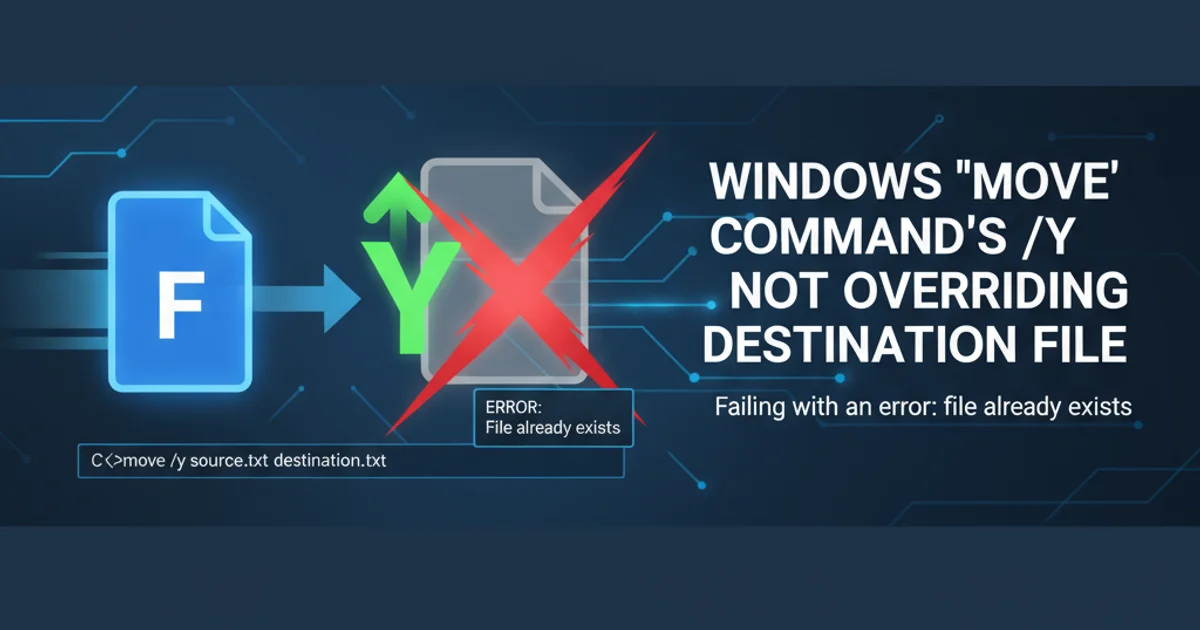Windows 'move' command's /y not overriding destiation file, failing with an error: file already e...
Categories:
Windows 'move' Command: /Y Flag Not Overriding Destination File, Failing with 'File Already Exists'

Investigate why the Windows move command's /Y flag might not be working as expected, leading to 'file already exists' errors, and explore solutions.
The move command in Windows Command Prompt (cmd.exe) is a fundamental utility for relocating files and directories. It includes a /Y switch, which is supposed to suppress prompting for confirmation when overwriting an existing destination file. However, users occasionally encounter scenarios where move /Y still fails with an 'Access is denied' or 'The file already exists' error, even when the intention is to overwrite. This article delves into the common causes of this unexpected behavior and provides practical solutions.
Understanding the '/Y' Switch and Its Limitations
The /Y switch for the move command is designed to prevent interactive prompts. When moving a file to a location where a file with the same name already exists, move will typically ask for confirmation: Overwrite [destination_file_path]? (Yes/No/All):. The /Y switch bypasses this prompt, automatically answering 'Yes'.
However, it's crucial to understand that /Y only handles the confirmation prompt. It does not override underlying operating system restrictions or file system issues that might prevent an overwrite. If the move command fails even with /Y, the problem is usually not with the switch itself, but with other factors preventing the file operation.
flowchart TD
A[Start Move Command] --> B{Is /Y switch used?}
B -->|No| C{Destination file exists?}
C -->|Yes| D["Prompt for overwrite (Y/N/A)"]
C -->|No| E[Move file]
B -->|Yes| F{Destination file exists?}
F -->|Yes| G{Can destination file be overwritten?}
G -->|Yes| E[Move file]
G -->|No| H["Error: 'File already exists' or 'Access denied'"]
F -->|No| E[Move file]
E --> I[End]
H --> I[End]Flowchart illustrating the logic of the 'move' command with and without the /Y switch.
Common Causes for 'File Already Exists' with /Y
Several factors can prevent move /Y from successfully overwriting a file. Identifying the root cause is key to resolving the issue.
1. File in Use or Locked
If the destination file (or even the source file) is currently open or in use by another process, the operating system will prevent it from being overwritten or deleted. This is a common reason for 'Access is denied' or 'The file already exists' errors, as the move command internally attempts to delete the destination file before moving the new one.
2. Insufficient Permissions
The user account executing the move command might not have the necessary write permissions to the destination directory or the permission to modify/delete the existing destination file. Even if you have write access to the folder, specific file permissions can override this.
3. Read-Only Attribute
If the destination file has the 'Read-only' attribute set, the move command will fail to overwrite it. The /Y switch does not bypass the read-only flag.
4. Hidden or System Files
Moving or overwriting hidden or system files can sometimes behave unexpectedly, especially if they are protected by the operating system.
5. Antivirus or Security Software
Aggressive antivirus or security software might temporarily lock files or prevent modifications, especially if the operation is deemed suspicious.
6. Network Drive Issues
When moving files to or from network shares, network latency, dropped connections, or specific share permissions can cause failures.
Solutions and Workarounds
Depending on the underlying cause, various strategies can be employed to successfully move and overwrite files.
1. Check for File Locks
Before attempting the move command, ensure that no applications are using the destination file. Close any programs that might have it open. For persistent issues, use tools like Process Explorer or Resource Monitor to identify the locking process.
2. Verify Permissions
Right-click the destination folder or file, go to 'Properties' -> 'Security' tab, and check the permissions for your user account. Ensure you have 'Modify' and 'Write' permissions. If not, adjust them or run the command from an elevated Command Prompt (Run as administrator).
3. Remove Read-Only Attribute
If the destination file is read-only, you can remove the attribute using the attrib command before moving:
attrib -R "C:\path\to\destination\file.txt"
move /Y "C:\path\to\source\file.txt" "C:\path\to\destination\file.txt"
4. Use 'del' then 'move'
A common workaround is to explicitly delete the destination file first, and then move the new file. This ensures the destination is clear. Use /F with del to force deletion of read-only files and /Q for quiet mode (no prompt).
DEL /F /Q "C:\path\to\destination\file.txt"
move "C:\path\to\source\file.txt" "C:\path\to\destination\file.txt"
Caution: This approach permanently deletes the destination file. Ensure you have backups if necessary.
5. Utilize 'robocopy' for Robust Operations
For more robust file operations, especially in scripts or batch files, robocopy is often preferred over move. robocopy is designed for reliable copying and moving, with extensive options for handling existing files, retries, and permissions. The /MOV switch moves files, and /IS (Include Same files) or /IT (Include Tweaked files) can be used to overwrite.
robocopy "C:\path\to\source\" "C:\path\to\destination\" "file.txt" /MOV /IS
This command moves file.txt from source to destination, overwriting if it exists. Note that robocopy works with directories, so you specify the source and destination folders and then the specific file(s) to move.
6. Temporarily Disable Antivirus
If you suspect antivirus interference, try temporarily disabling it (with caution) to see if the move command succeeds. Remember to re-enable it immediately afterward.
:: Example of a robust move operation using DEL and MOVE
SET "SOURCE_FILE=C:\Temp\MyDocument.txt"
SET "DEST_FILE=D:\Archive\MyDocument.txt"
IF EXIST "%DEST_FILE%" (
ECHO Destination file exists. Attempting to delete...
DEL /F /Q "%DEST_FILE%"
IF ERRORLEVEL 1 (
ECHO ERROR: Could not delete destination file. It might be locked or protected.
GOTO :EOF
)
)
move /Y "%SOURCE_FILE%" "%DEST_FILE%"
IF ERRORLEVEL 1 (
ECHO ERROR: Failed to move file.
) ELSE (
ECHO File moved successfully.
)
Batch script demonstrating a robust file move operation with explicit deletion.
DEL /F /Q, be absolutely certain of the file path. There is no undo for this command, and it will delete files without prompting, even if they are read-only.